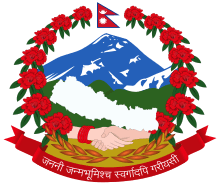Lumbini
Lumbinī (Nepali and Sanskrit: लुम्बिनी ![]()
Lumbini लुम्बिनी | |
|---|---|
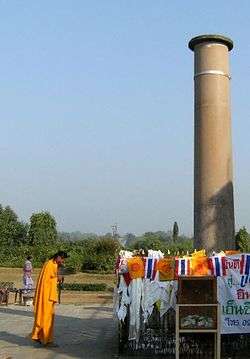 | |
 Lumbini Location of Lumbini in Nepal | |
| Coordinates: 27°28′53″N 83°16′33″E | |
| Country | Nepal |
| Province | Province No. 5 |
| District | Rupandehi |
| Municipality | Lumbini Sanskritik |
| Government | |
| • Type | Development trust |
| • Body | Lumbini Development Trust |
| Elevation | 150 m (490 ft) |
| Time zone | UTC+05:45 (NST) |
| Postal Code | 32914 |
| Website | www |
| UNESCO World Heritage Site | |
|---|---|
| Location | Rupandehi District, Nepal |
| Criteria | Cultural: iii, vi |
| Reference | 666 |
| Inscription | 1997 (21st session) |
| Area | 1.95 ha |
| Buffer zone | 22.78 ha |
| Coordinates | |
Lumbini has a number of older temples, including the Mayadevi Temple, and various new temples, funded by Buddhist organisations from various countries, have been completed or are still under construction. Many monuments, monasteries and a museum, and the Lumbini International Research Institute are also within the holy site. Also, there is the Puskarini, or Holy Pond, where the Buddha's mother took the ritual dip prior to his birth and where he had his first bath. At other sites near Lumbini, earlier Buddhas were, according to tradition, born, then achieved ultimate Enlightenment and finally relinquished their earthly forms.
Lumbini was made a World Heritage Site by UNESCO in 1997.[1][2]
In Buddha's time
In the Buddha's time, Lumbini was situated in east of Kapilavastu and southwest Devadaha of Shakya, an oligarchic republic.[8][9] According to Buddhist tradition, it was there, that the Buddha was born.[10] A pillar discovered at Rupandehi in 1896 is believed to mark the spot of Ashoka's visit to Lumbini. The site was not known as Lumbini before the pillar was discovered.[11] The translation of Inscription reads:[12] "When King Devanampriya Priyadarsin had been anointed twenty years, he came himself and worshipped (this spot) because the Buddha Shakyamuni was born here. (He) both caused to be made a stone bearing a horse (?) and caused a stone pillar to be set up, (in order to show) that the Blessed One was born here. (He) made the village of Lummini free of taxes, and paying (only) an eighth share (of the produce)." [13] The park was previously known as Rupandehi, 2 mi (2 mi (3.2 km)) north of Bhagavanpura.
The Sutta Nipáta (vs. 683) states that the Buddha was born in a village of the Sákyans in the Lumbineyya Janapada. The Buddha stayed in Lumbinívana during his visit to Devadaha and there preached the Devadaha Sutta.[14]
Pillar of Ashoka
In 1896, General Khadga Samsher Rana and Alois Anton Führer discovered a great stone pillar at Rupandehi, according to the crucial historical records made by the ancient Chinese monk-pilgrim Xuanzang in the 7th century CE and by another ancient Chinese monk-pilgrim Faxian in the early 5th century CE. The Brahmi inscription on the pillar gives evidence that Ashoka, emperor of the Maurya Empire, visited the place in 3rd-century BCE and identified it as the birth-place of the Buddha. The inscription was translated by Paranavitana:[15][note 1]
| Translation (English) | Transliteration (original Brahmi script) | Inscription (Prakrit in the Brahmi script) |
|---|---|---|
|
|
|
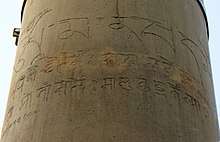
At the top of the pillar, there is a second inscription by king Ripumalla (13-14th century CE), who is also known from an inscription at the Nigali Sagar pillar:
"Om mani padme hum May Prince Ripu Malla be long victorious"
A second pillar of Ashoka is located about 22 kilometers to the northwest of Lumbini, the Nigali Sagar pillar (with inscription), and a third one 24 kilometers to the west, the Gotihawa pillar (without inscription).
Excavation at the Mayadevi Temple in 2013
.jpg)
According to Robin Coningham, excavations beneath existing brick structures at the Mayadevi Temple at Lumbini provide evidence for an older timber structure beneath the walls of a brick Buddhist shrine built during the Ashokan era (3rd-century BCE). The layout of the Ashokan shrine closely follows that of the earlier timber structure, which suggests a continuity of worship at the site. The pre-Mauryan timber structure appears to be an ancient tree shrine. Radiocarbon dating of charcoal from the wooden postholes and optically stimulated luminescence dating of elements in the soil suggests human activity began at Lumbini around 1000 BCE.[24] The site, states Coningham, may be a Buddhist monument from 6th-century BCE. Other scholars state that the excavations revealed nothing that is Buddhist, and they only confirm that the site predates the Buddha.[25][26]
Present-day

Lumbini is 4.8 km (3 mi) in length and 1.6 km (1.0 mi) in width. The holy site of Lumbini is bordered by a large monastic zone in which only monasteries can be built, no shops, hotels or restaurants. It is separated into an eastern and western monastic zone, the eastern having the Theravadin monasteries, the western having Mahayana and Vajrayana monasteries. There is a long water filled canal separating the western and eastern zones, with a series of brick arch bridges joining the two sides along the length. The canal is serviced by simple outboard motor boats at the north end which provides tours.
The holy site of Lumbini has ruins of ancient monasteries, a sacred Bodhi tree, an ancient bathing pond, the Ashokan pillar and the Mayadevi Temple, a site traditionally considered to be the birthplace of the Buddha. From early morning to early evening, pilgrims from various countries perform chanting and meditation at the site.
A non-governmental organization named Samriddhi Foundation started in 2013 working extensively in the field of education and health specially in government schools of the area where underprivileged children study. A non-governmental organisation called "Asia Pacific Exchange and Co-operation Foundation" (APECF) backed by chairman of the Unified Communist Party of Nepal (Maoist) and then Prime Minister Prachanda, the Chinese government and a UN group called "United Nations Industrial Development Organization" (UNIDO) signed a deal to develop Lumbini into a "special development zone" with funds worth $3 billion.[27] The venture was a China-UN joint project. A broader 'Lumbini Development National Director Committee' under the leadership of Pushpa Kamal Dahal was formed on 17 October 2011.[28] The six-member committee included Communist Party of Nepal (Unified Marxist-Leninist) leader Mangal Siddhi Manandhar, Nepali Congress leader Minendra Rijal, Forest Minister Mohammad Wakil Musalman, among other leaders. The committee was given the authority to "draft a master plan to develop Lumbini as a peaceful and tourism area and table the proposal" and the responsibility to gather international support for the same.[28]
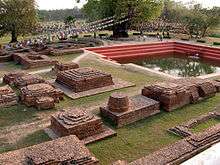
Nipponzan Myohoji decided to build a Peace Pagoda in the park in 2001, which is visited by many different cultures and religions every day.
Because some Hindus regard the Buddha as an incarnation of Vishnu, thousands of Hindus have begun to come here on pilgrimage during the full moon of the Nepali month of Baisakh (April–May) to worship Queen Mayadevi as Rupa Devi, the mother goddess of Lumbini.
Lumbini was granted World Heritage status by UNESCO in 1997.[1][2]
On the Nepali rupee
Nepal's central bank has introduced a 100-rupee Nepali note featuring Lumbini, the birthplace of Buddha. The Nepal Rastra Bank said the new note would be accessible only during the Dashain, Nepal's major festival in the time of September/October. It displays the portrait of Mayadevi, Gautam Buddha's mother in silver metallic on the front. The note also has a black dot which would help the blind recognise the note. The name of the central bank in Latin script would be printed on the note along with the date of printing in both the Christian Era and the Bikram Era. The new note is being issued following a cabinet decision 27 August.[29]
Transport

Lumbini is a 10-hour drive from Kathmandu and a 30-minute drive from Bhairahawa. The closest airport is Gautam Buddha Airport at Bhairahawa, with flights to and from Kathmandu.[30]
The India border town of Sonauli in Maharajganj district is 1 hour drive from Lumbini and Nautanwa railway station in India is just a few kilometres away. The nearest big city is Gorakhpur, which is about 100km and is 4 hours drive from Lumbini.
Places to visit in Lumbini
- Maya Devi Temple
- World Peace Pagoda
- Myanmar Golden Temple
- Ashoka Pillar
- Lumbini Crane Sanctuary[31]
New Hotel Construction in Lumbini
The nearest airport to Lumbini, that is, the Gautam Buddha Airport in Bhairahawa, is currently undergoing upgradation work. This small domestic airport is soon expected to become an international airport, with latest deadline set for 2019. The upgradation work of the airport has also caught the eye of investors and hoteliers, and a series of new hotels are being constructed now in and around Lumbini, hoping to catch in on the expected international tourist boom once the airport upgradation work is complete.[32]
Foreign visitors (2012–2014)
| Year | Jan | Feb | Mar | Apr | May | Jun | Jul | Aug | Sept | Oct | Nov | Dec | Total |
|---|---|---|---|---|---|---|---|---|---|---|---|---|---|
| 2014 | 8,356 | 17,964 | 20,037 | 6,843 | 2,553 | 2,111 | 2,726 | 14,123 | 7,999 | 16,433 | 21,089 | 12,765 | 132,926[33] |
| 2013 | 9,371 | 17,869 | 22,581 | 7,101 | 3,654 | 3,552 | 3,621 | 9,685 | 7,351 | 13,610 | 16,483 | 10,618 | 125,496[34] |
| 2012 | 6,591 | 20,045 | 20,519 | 8,295 | 1,316 | 1,366 | 2,651 | 17,924 | 7,955 | 13,099 | 21,740 | 14,566 | 136,067[34] |
See also
| Pilgrimage to |
| Buddha's Holy Sites |
|---|
 |
| The Four Main Sites |
| Four Additional Sites |
| Other Sites |
|
| Later Sites |
|
References
- UNESCO World Heritage Centre - World Heritage Committee Inscribes 46 New Sites on World Heritage List
- "Lumbini, the Birthplace of the Lord Buddha". UNESCO. Retrieved 1 March 2011.
- Cousins, LS (1996). "The Dating of the Historical Buddha: A Review Article". Journal of the Royal Asiatic Society. 6 (1): 57–63. doi:10.1017/s1356186300014760. JSTOR 25183119. Archived from the original on 24 December 2010.
- Schumann, Hans Wolfgang (2003). The Historical Buddha: The Times, Life, and Teachings of the Founder of Buddhism. Motilal Banarsidass Press. pp. 10–13. ISBN 8120818172.
- "Lumbini, the Birthplace of the Lord Buddha – UNESCO World Heritage Centre". Whc.unesco.org. Retrieved 19 August 2013.
- ""Gautama Buddha (B.C. 623-543)" by T.W. Rhys-Davids, The World's Great Events, B.C. 4004-A.D. 70 (1908) by Esther Singleton, pp. 124–35". Unz.org. 28 November 2012. Retrieved 19 August 2013.
- "The Buddha (BC 623-BC 543) – Religion and spirituality Article – Buddha, Bc, 623". Booksie. 8 July 2012. Retrieved 19 August 2013.
- "Ramagrama-Devadaha | Lumbini Development Trust". lumbini.planetwebnepal.com. Lumbini Development Trust. 2013. Retrieved 29 September 2016.
- Violatti, Cristian (12 December 2013). "Kapilavastu". Kapilavastu - Ancient History Encyclopedia. Ancient History Encyclopedia. Archived from the original on 14 August 2016. Retrieved 29 September 2016.
- J.i.52, 54; Kvu.97, 559; AA.i.10; MA.ii.924; BuA.227; Cv.li.10, etc.
- Sen, Dr. A. C. (2008). Buddhist shrines in India. Kolkota: Maha Bodhi Book Agency. p. 24. ISBN 978-81-87032-78-6.
- See Mukerji: Asoka, p. 27; see p. 201f for details
- See Mukerji: Asoka, p. 27; see p. 201f for details
- MA.ii.810
- Paranavitana, S. (Apr. - Jun., 1962). Rupandehi Pillar Inscription of Asoka, Journal of the American Oriental Society, 82 (2), 163-167
- Weise, Kai; et al. (2013), The Sacred Garden of Lumbini – Perceptions of Buddha's Birthplace (PDF), Paris: UNESCO, pp. 47–48, archived from the original (PDF) on 30 August 2014
- Hultzsch, E. /1925). Inscriptions of Asoka. Oxford: Clarendon Press, pp. 164-165
- Hultzsch, E. (1925). Inscriptions of Asoka. Oxford: Clarendon Press, pp. 164-165
- Hultzsch, E. (1925). Inscriptions of Asoka. New Edition by E. Hultzsch (in Sanskrit). p. 164.
- British Library Online
- "Dr. Fuhrer went from Nigliva to Rummindei where another Priyadasin lat has been discovered... and an inscription about 3 feet below surface, had been opened by the Nepalese" in Calcutta, Maha Bodhi Society (1921). The Maha-Bodhi. p. 226.
- Le Huu Phuoc, Buddhist Architecture, p.269
- Le Huu Phuoc, Buddhist Architecture, p.269
- Coningham, RAE; Acharya, KP; Strickland, KM; Davis, CE; Manuel, MJ; Simpson, IA; Gilliland, K; Tremblay, J; Kinnaird, TC; Sanderson, DCW (2013). "The earliest Buddhist shrine: excavating the birthplace of the Buddha, Lumbini (Nepal)" (PDF). Antiquity. 87 (338): 1104–23. doi:10.1017/s0003598x00049899. Archived from the original (PDF) on 5 December 2014.
- Richard Gombrich (2013), Pseudo-discoveries at Lumbini, Oxford Center for Buddhist Studies, Oxford University
- Lars Fogelin (2 March 2015). An Archaeological History of Indian Buddhism. Oxford University Press. ISBN 978-0-19-994822-2.
- "Programs/Projects >> UNIDO IP Projects >> Introduction". UNIDOitpo.org. Archived from the original on 11 July 2018. Retrieved 15 July 2011.
- "Lumbini Development Committee formed under Dahal's leadership". ekantipur. Archived from the original on 21 December 2011. Retrieved 17 October 2011.
- Buddha’s birthplace in Nepal’s 100-rupee note – Indistan News – National, Political and States News Archived 2 December 2013 at the Wayback Machine
- "Lumbini". Welcome Nepal. Archived from the original on 17 August 2013. Retrieved 19 August 2013.
- "Things to do in Lumbini".
- "Airport construction triggers hotel boom in Rupandehi". Retrieved 11 July 2018.
- "Archived copy" (PDF). Archived from the original (PDF) on 26 April 2016. Retrieved 29 April 2016.CS1 maint: archived copy as title (link)
- "Archived copy" (PDF). Archived from the original (PDF) on 11 September 2014. Retrieved 9 September 2014.CS1 maint: archived copy as title (link)
- "MoU on Twinning arrangements between Kathmandu-Varanasi, Janakpur-Ayodhya and Lumbini-Bodh Gaya as sister cities". pib.gov.in. Retrieved 8 March 2020.
Bibliography
- Weise, Kai; et al. (2013), The Sacred Garden of Lumbini – Perceptions of Buddha's Birthplace (PDF), Paris: UNESCO, archived from the original (PDF) on 30 August 2014
External links
| Wikimedia Commons has media related to Lumbini. |
- Lumbini On Trial: The Untold Story

- Lumbini at the Open Directory Project
- Lumbini at WorldHeritageSite.org Listing
| Edicts of Ashoka (Ruled 269–232 BCE) | |||||
| Regnal years of Ashoka |
Type of Edict (and location of the inscriptions) |
Geographical location | |||
| Year 8 | End of the Kalinga war and conversion to the "Dharma" | 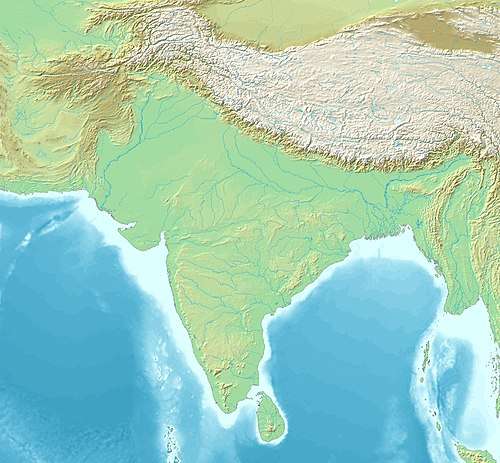 Udegolam Nittur Brahmagiri Jatinga Rajula Mandagiri Yerragudi Sasaram Barabar Kandahar (Greek and Aramaic) Kandahar Khalsi Ai Khanoum (Greek city) | |||
| Year 10[1] | Minor Rock Edicts | Related events: Visit to the Bodhi tree in Bodh Gaya Construction of the Mahabodhi Temple and Diamond throne in Bodh Gaya Predication throughout India. Dissenssions in the Sangha Third Buddhist Council In Indian language: Sohgaura inscription Erection of the Pillars of Ashoka | |||
| Kandahar Bilingual Rock Inscription (in Greek and Aramaic, Kandahar) | |||||
| Minor Rock Edicts in Aramaic: Laghman Inscription, Taxila inscription | |||||
| Year 11 and later | Minor Rock Edicts (n°1, n°2 and n°3) (Panguraria, Maski, Palkigundu and Gavimath, Bahapur/Srinivaspuri, Bairat, Ahraura, Gujarra, Sasaram, Rajula Mandagiri, Yerragudi, Udegolam, Nittur, Brahmagiri, Siddapur, Jatinga-Rameshwara) | ||||
| Year 12 and later[1] | Barabar Caves inscriptions | Major Rock Edicts | |||
| Minor Pillar Edicts | Major Rock Edicts in Greek: Edicts n°12-13 (Kandahar) Major Rock Edicts in Indian language: Edicts No.1 ~ No.14 (in Kharoshthi script: Shahbazgarhi, Mansehra Edicts (in Brahmi script: Kalsi, Girnar, Sopara, Sannati, Yerragudi, Delhi Edicts) Major Rock Edicts 1-10, 14, Separate Edicts 1&2: (Dhauli, Jaugada) | ||||
| Schism Edict, Queen's Edict (Sarnath Sanchi Allahabad) Lumbini inscription, Nigali Sagar inscription | |||||
| Year 26, 27 and later[1] |
Major Pillar Edicts | ||||
| In Indian language: Major Pillar Edicts No.1 ~ No.7 (Allahabad pillar Delhi pillar Topra Kalan Rampurva Lauria Nandangarh Lauriya-Araraj Amaravati) Derived inscriptions in Aramaic, on rock: | |||||

